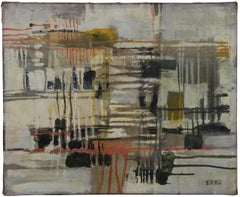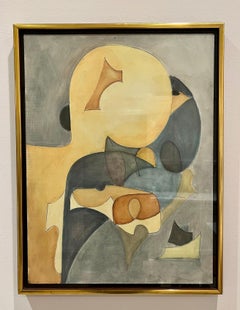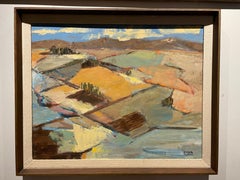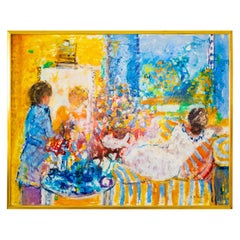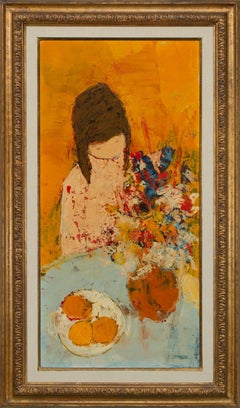Willering Epko Art
to
1
2
2
2
2
"Barbed Wire", Oil on Canvas by Willering Epko
By Willering Epko
Located in Long Island City, NY
Artist: Willering Epko, French (1928 - )
Title: Barbed Wire
Medium: Oil on Canvas, signed l.r.
Size: 29 in. x 36 in. (73.66 cm x 91.44 cm)
Frame Size: 32 x 39 inches
Category
1960s Modern Willering Epko Art
Materials
Oil
Modern Abstract Oil on Canvas by Willering Epko
By Willering Epko
Located in Long Island City, NY
Artist: Willering Epko, French (1928 - )
Title: Untitled
Year: circa 1950
Medium: Oil on Canvas, signed l.r.
Size: 15 in. x 18 in. (38.1 cm x 45.72 cm)
Category
1960s Modern Willering Epko Art
Materials
Oil
Related Items
American School, Abstract Untitled
Located in New Orleans, LA
American School, Artist Unknown
Category
Early 20th Century American Modern Willering Epko Art
Materials
Oil, Board
Vintage Southern California Abstract Landscape Painting - Katharyn Truesdell 70s
Located in Baltimore, MD
Katharyn Gwendoln Truesdell - (American; 1909-1996)
This colorful painting depicts a Southern California valley, likely near Sun City, over the mountains from Los Angeles and San Di...
Category
1970s American Modern Willering Epko Art
Materials
Oil
The Orchestra
Located in Los Angeles, CA
The Orchestra, 1950, oil on canvas, 21 ½ x 25 3/4 inches, signed and dated lower left, labeled verso “Brown University, Trustee, The Walter Feldman Trus...
Category
Mid-20th Century American Modern Willering Epko Art
Materials
Canvas, Oil
Energy Manifestation #4
Located in Los Angeles, CA
Energy Manifestation #4, 1933, oil on canvas, 24 x 30 inches, signed and dated lower left. Likely exhibited at Nicolaides’ solo show at the Wadsworth Atheneum (Morgan Memorial Building), Hartford, Connecticut, in April, 1933 (see Memorial Opens Varied Display of Nicolaides Work, Originality Distinguishes Creations of New York City Artist, Hartford Courant, April 5, 1933)
About the Painting
This rare work comes from Nicolaides’ energy series, which draws on a unique combination of machine- age aesthetics, Italian-influenced Futurism and French-inspired Surrealism. But, this is a uniquely American work produced in the melting pot of the 1930s metropolis, New York City. Nicolaides uses the ray lines of the American precisionists to frame a pulsating apparatus that unites man and machine as one. The cogs and gears of the fantasy machine seamlessly blend with the hand of its operator. We are left to wonder whether the two are working together in harmony or whether the worker has been absorbed into the machine, like a Depression era robot. In reviewing the 1933 Wadsworth Atheneum show, where works from Nicolaides’ energy series were exhibited, a critic described these paintings as “combining . . . highly imaginative form aspects of machinery and flashes of color which seem to represent light and heat.” The same critic praised the artist, “Mr. Nicolaides here achieves powerful effects with line, mass and color. These pictures are striking for the solidity of the objects portrayed, for their composition and for their delicate orchestration of tones.” Commenting on the same exhibition, Frederick Hynd, the director of the Hartford Art School, noted that “Mr. Nicolaides’ work was noteworthy for its extremely personal sense of color and for its imagination” and that the artist achieved decorative effects “based on emotional ideas.”
About the Artist
Kimon Nicolaides...
Category
1930s American Modern Willering Epko Art
Materials
Oil
Ceremonial Dancers oil and tempera painting by Julio De Diego
By Julio de Diego
Located in Hudson, NY
Artwork measures 48" x 30" and framed 56 ¼" x 38 ¼" x 3"
Provenance:
John Heller Gallery, NYC, circa 1975 (label verso)
The artist's daughter
Corbino Galleries, Sarasota, FL (1990)...
Category
1940s Modern Willering Epko Art
Materials
Masonite, Oil, Tempera
The Magician oil and tempera painting by Julio de Diego
By Julio de Diego
Located in Hudson, NY
Julio De Diego’s Atomic Series paintings made an extraordinary statement regarding the shock and fear that accompanied the dawn of the nuclear age. In the artist’s own words, “Scientists were working secretly to develop formidable powers taken from the mysterious depths of the earth - with the power to make the earth useless! Then, the EXPLOSION! . . . we entered the Atomic Age, and from there the neo-Atomic war begins. Explosions fell everywhere and man kept on fighting, discovering he could fight without flesh.”
To execute these works, De Diego developed a technique of using tempera underpainting before applying layer upon layer of pigmented oil glazes. The result is paintings with surfaces which were described as “bonelike” in quality. The forms seem to float freely, creating a three-dimensional visual effect. In the 1954 book The Modern Renaissance in American Art, author Ralph Pearson summarizes the series as “a fantastic interpretation of a weighty theme. Perhaps it is well to let fantasy and irony appear to lighten the devastating impact. By inverse action, they may in fact increase its weight.”
Exhibited
1964 Marion Koogler McNay Art Institute, San Antonio, Texas
This work retains its original frame which measures 54" x 42" x 2"
About this artist: Julio De Diego crafted a formidable persona within the artistic developments and political struggles of his time. The artist characterized his own work as “lyrical,” explaining, “through the years, the surrealists, the social-conscious painters and the others tried to adopt me, but I went my own way, good, bad or indifferent.” [1] His independence manifested early in life when de Diego left his parent’s home in Madrid, Spain, in adolescence following his father’s attempts to curtail his artistic aspirations. At the age of fifteen he held his first exhibition, set up within a gambling casino. He managed to acquire an apprenticeship in a studio producing scenery for Madrid’s operas, but moved from behind the curtains to the stage, trying his hand at acting and performing as an extra in the Ballet Russes’ Petrouchka with Nijinsky. He spent several years in the Spanish army, including a six-month stretch in the Rif War of 1920 in Northern Africa. His artistic career pushed ahead as he set off for Paris and became familiar with modernism’s forays into abstraction, surrealism, and cubism.
The artist arrived in the U.S. in 1924 and settled in Chicago two years later. He established himself with a commission for the decoration of two chapels in St. Gregory’s Church. He also worked in fashion illustration, designed magazine covers and developed a popular laundry bag for the Hotel Sherman. De Diego began exhibiting through the Art Institute of Chicago in 1929, and participated in the annual Chicago Artists Exhibitions, Annual American Exhibitions, and International Water Color Exhibitions. He held a solo exhibition at the Art Institute of Chicago in the summer of 1935. Though the artist’s career was advancing, his family life had deteriorated. In 1932 his first marriage dissolved, and the couple’s young daughter Kiriki was sent to live with friend Paul Hoffman.
De Diego continued to develop his artistic vocabulary with a growing interest in Mexican art. He traveled throughout the country acquainting himself with the works of muralists such as Carlos Merida, and also began a collection of small native artifacts...
Category
1940s American Modern Willering Epko Art
Materials
Masonite, Oil, Tempera
St. Atomic oil and tempera painting by Julio de Diego
By Julio de Diego
Located in Hudson, NY
Julio De Diego’s Atomic Series paintings made an extraordinary statement regarding the shock and fear that accompanied the dawn of the nuclear age. In the artist’s own words, “Scientists were working secretly to develop formidable powers taken from the mysterious depths of the earth - with the power to make the earth useless! Then, the EXPLOSION! . . . we entered the Atomic Age, and from there the neo-Atomic war begins. Explosions fell everywhere and man kept on fighting, discovering he could fight without flesh.”
To execute these works, De Diego developed a technique of using tempera underpainting before applying layer upon layer of pigmented oil glazes. The result is paintings with surfaces which were described as “bonelike” in quality. The forms seem to float freely, creating a three-dimensional visual effect. In the 1954 book The Modern Renaissance in American Art, author Ralph Pearson summarizes the series as “a fantastic interpretation of a weighty theme. Perhaps it is well to let fantasy and irony appear to lighten the devastating impact. By inverse action, they may in fact increase its weight.”
Exhibited
1950 University of Illinois at Urbana "Contemporary American Painting"
1964 Marion Koogler McNay Art Institute, San Antonio, Texas
This work retains its original frame which measures 54" x 36" x 2".
About this artist: Julio De Diego crafted a formidable persona within the artistic developments and political struggles of his time. The artist characterized his own work as “lyrical,” explaining, “through the years, the surrealists, the social-conscious painters and the others tried to adopt me, but I went my own way, good, bad or indifferent.” [1] His independence manifested early in life when de Diego left his parent’s home in Madrid, Spain, in adolescence following his father’s attempts to curtail his artistic aspirations. At the age of fifteen he held his first exhibition, set up within a gambling casino. He managed to acquire an apprenticeship in a studio producing scenery for Madrid’s operas, but moved from behind the curtains to the stage, trying his hand at acting and performing as an extra in the Ballet Russes’ Petrouchka with Nijinsky. He spent several years in the Spanish army, including a six-month stretch in the Rif War of 1920 in Northern Africa. His artistic career pushed ahead as he set off for Paris and became familiar with modernism’s forays into abstraction, surrealism, and cubism.
The artist arrived in the U.S. in 1924 and settled in Chicago two years later. He established himself with a commission for the decoration of two chapels in St. Gregory’s Church. He also worked in fashion illustration, designed magazine covers and developed a popular laundry bag for the Hotel Sherman. De Diego began exhibiting through the Art Institute of Chicago in 1929, and participated in the annual Chicago Artists Exhibitions, Annual American Exhibitions, and International Water Color Exhibitions. He held a solo exhibition at the Art Institute of Chicago in the summer of 1935. Though the artist’s career was advancing, his family life had deteriorated. In 1932 his first marriage dissolved, and the couple’s young daughter Kiriki was sent to live with friend Paul Hoffman.
De Diego continued to develop his artistic vocabulary with a growing interest in Mexican art. He traveled throughout the country acquainting himself with the works of muralists such as Carlos Merida, and also began a collection of small native artifacts...
Category
1940s American Modern Willering Epko Art
Materials
Masonite, Oil, Tempera
Moon Glow by Robert Terry
Located in Brookville, NY
Born 1955 in Broken Bow, Nebraska. Lives and works in New York.
AWARDS
National Endowment for the Arts, Major Grant
Robert Terry was best noted in his depictions of romantic moons...
Category
1990s American Modern Willering Epko Art
Materials
Oil
White Rabbit with Stars
By FPA Francis Pavy Artist
Located in Lafayette, LA
Here is an Original work by Louisiana Artist Francis X Pavy -entitled White Rabbit with Stars.
About Francis X Pavy
In the vast tapestry of the art world, Art collectors are attra...
Category
Early 2000s Modern Willering Epko Art
Materials
Oil
Cangiante Arancione
By Giulio Turcato
Located in Firenze, FI
Giulio Turcato (Mantova, 16 marzo 1912 – Roma, 22 gennaio 1995) è stato un artista italiano, fra i principali esponenti dell'astrattismo informale italiano.
Category
1980s Modern Willering Epko Art
Materials
Canvas, Mixed Media, Oil
Inevitable Day – Birth of the Atom oil and tempera painting by Julio De Diego
By Julio de Diego
Located in Hudson, NY
Julio De Diego’s Atomic Series paintings made an extraordinary statement regarding the shock and fear that accompanied the dawn of the nuclear age. In the artist’s own words, “Scientists were working secretly to develop formidable powers taken from the mysterious depths of the earth - with the power to make the earth useless! Then, the EXPLOSION! . . . we entered the Atomic Age, and from there the neo-Atomic war begins. Explosions fell everywhere and man kept on fighting, discovering he could fight without flesh.”
To execute these works, De Diego developed a technique of using tempera underpainting before applying layer upon layer of pigmented oil glazes. The result is paintings with surfaces which were described as “bonelike” in quality. The forms seem to float freely, creating a three-dimensional visual effect. In the 1954 book The Modern Renaissance in American Art, author Ralph Pearson summarizes the series as “a fantastic interpretation of a weighty theme. Perhaps it is well to let fantasy and irony appear to lighten the devastating impact. By inverse action, they may in fact increase its weight.”
Bibliography
Art in America, April 1951, p.78
About this artists: Julio De Diego crafted a formidable persona within the artistic developments and political struggles of his time. The artist characterized his own work as “lyrical,” explaining, “through the years, the surrealists, the social-conscious painters and the others tried to adopt me, but I went my own way, good, bad or indifferent.” [1] His independence manifested early in life when de Diego left his parent’s home in Madrid, Spain, in adolescence following his father’s attempts to curtail his artistic aspirations. At the age of fifteen he held his first exhibition, set up within a gambling casino. He managed to acquire an apprenticeship in a studio producing scenery for Madrid’s operas, but moved from behind the curtains to the stage, trying his hand at acting and performing as an extra in the Ballet Russes’ Petrouchka with Nijinsky. He spent several years in the Spanish army, including a six-month stretch in the Rif War of 1920 in Northern Africa. His artistic career pushed ahead as he set off for Paris and became familiar with modernism’s forays into abstraction, surrealism, and cubism.
The artist arrived in the U.S. in 1924 and settled in Chicago two years later. He established himself with a commission for the decoration of two chapels in St. Gregory’s Church. He also worked in fashion illustration, designed magazine covers and developed a popular laundry bag for the Hotel Sherman. De Diego began exhibiting through the Art Institute of Chicago in 1929, and participated in the annual Chicago Artists Exhibitions, Annual American Exhibitions, and International Water Color Exhibitions. He held a solo exhibition at the Art Institute of Chicago in the summer of 1935. Though the artist’s career was advancing, his family life had deteriorated. In 1932 his first marriage dissolved, and the couple’s young daughter Kiriki was sent to live with friend Paul Hoffman.
De Diego continued to develop his artistic vocabulary with a growing interest in Mexican art. He traveled throughout the country acquainting himself with the works of muralists such as Carlos Merida, and also began a collection of small native artifacts...
Category
1940s American Modern Willering Epko Art
Materials
Masonite, Oil, Tempera
Sunset portraits
By FPA Francis Pavy Artist
Located in Lafayette, LA
This small painting is entitled Sunset Portraits. It's an oil painting on canvas mounted on wood. The painting depicts a man's silhouette
formed by fl...
Category
2010s American Modern Willering Epko Art
Materials
Oil
Previously Available Items
Figural Abstract Oil Painting by Willering Epko
By Willering Epko
Located in Palm Desert, CA
This art piece is a large format framed figural abstract oil painting by Willering Epko. Signed in the lower right corner. Born in the Netherlands, Willering Epko has won numerous aw...
Category
1970s French Mid-Century Modern Vintage Willering Epko Art
Materials
Canvas
Still Life and Figurative Oil Painting on Canvas by Willering Epko, Framed
By Willering Epko
Located in Encino, CA
Untitled, a still life and figurative abstract original oil on canvas by Willering Epko, is a piece for the true collector. Epko's striking use of color has been applauded for his di...
Category
1960s Post-Impressionist Willering Epko Art
Materials
Oil
Large Fauvist Expressionist Oil Painting Kids, Balloons, French Flags, Colorful
By Willering Epko
Located in Surfside, FL
Colorful, bright park scene with French flags and balloons and trees. Possibly a day at the horse race. Canvas measures 24X34 inches.
Epko Albert Jan Willering was a mid century School of Paris Dutch artist. Born in the Netherlands, Holland in 1928, Epko`s work has been exhibited worldwide in galleries in Montreal, Caracas, Munich, New York, Paris, Italy and in the Netherlands and can be found in the permanent collections of museums worldwide. Epko received awards and prizes in Paris for his work as well as the `Popular Vote Prize` in New York City in 1960. Epko not only was able to perfect his own style, heightened by a technique based on colour and its texture, but above all, that he succeeded in exploiting all this talent to become one of the artists that cannot be ignored on the international scene. 1958 – Prix Lefranc 1960 - The prestigious Prix Othon Friesz. 1960 - Collector’s Prize. He showed at the prestigious Felix Vercel gallery. They showed Pablo Picasso, Marc Chagall, Claude Venard, Jacques Bouyssou and René...
Category
Mid-20th Century Post-Impressionist Willering Epko Art
Materials
Canvas, Oil
Willering Epko art for sale on 1stDibs.
Find a wide variety of authentic Willering Epko art available for sale on 1stDibs. You can also browse by medium to find art by Willering Epko in oil paint, paint and more. Much of the original work by this artist or collective was created during the 1960s and is mostly associated with the modern style. Not every interior allows for large Willering Epko art, so small editions measuring 18 inches across are available. Customers who are interested in this artist might also find the work of Roger Lersy, Pierre Marie Brisson, and Etienne Ret. Willering Epko art prices can differ depending upon medium, time period and other attributes. On 1stDibs, the price for these items starts at $3,000 and tops out at $3,500, while the average work can sell for $3,250.

